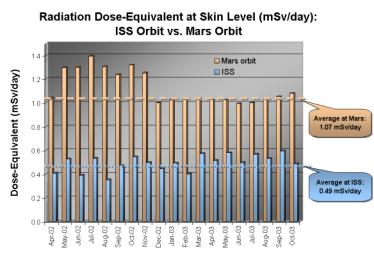
|
Radiation Environment at Mars and Earth
- Click the image above for a larger view
- Full-Res JPEG (907 x 621) (102.2 kB)
- Full-Res TIFF (907 x 621) (348.2 kB)
Caption:
December 8, 2003
This graphic shows the radiation dose equivalent as measured by Odyssey's martian radiation environment experiment at Mars and by instruments aboard the Earth-orbiting International Space Station (ISS), for the 18-month period from April 2002 through October 2003. The accumulated total in Mars orbit is just over two times larger than that aboard the Space Station. The bars where the Mars instrument's measurements are well above the average (as shown by the orange line) are months when there was significant solar activity, which increases the dose equivalent. Dose equivalent is expressed in units of milliSieverts per day.
Background Info:
NASA's Jet Propulsion Laboratory manages the 2001 Mars Odyssey mission for NASA's Office of Space Science, Washington. The radiation experiment was provided by the Johnson Space Center, Houston, Texas. Lockheed Martin Space Systems, Denver, Colo., is the prime contractor for the project, and developed and built the orbiter. Mission operations are conducted jointly from Lockheed Martin and from JPL, a division of the California Institute of Technology in Pasadena.
Cataloging Keywords:
| Name | Value | Additional Values |
|---|---|---|
| Target | Mars | |
| System | ||
| Target Type | Planet | |
| Mission | 2001 Mars Odyssey | |
| Instrument Host | Mars Odyssey | |
| Host Type | Orbiter | |
| Instrument | Mars Radiation Environment Experiment (MARIE) | |
| Detector | ||
| Extra Keywords | Color | |
| Acquisition Date | ||
| Release Date | 2003-12-08 | |
| Date in Caption | 2003-12-08 | |
| Image Credit | NASA/JPL/Johnson Space Center | |
| Source | photojournal.jpl.nasa.gov/catalog/PIA04909 | |
| Identifier | PIA04909 | |
